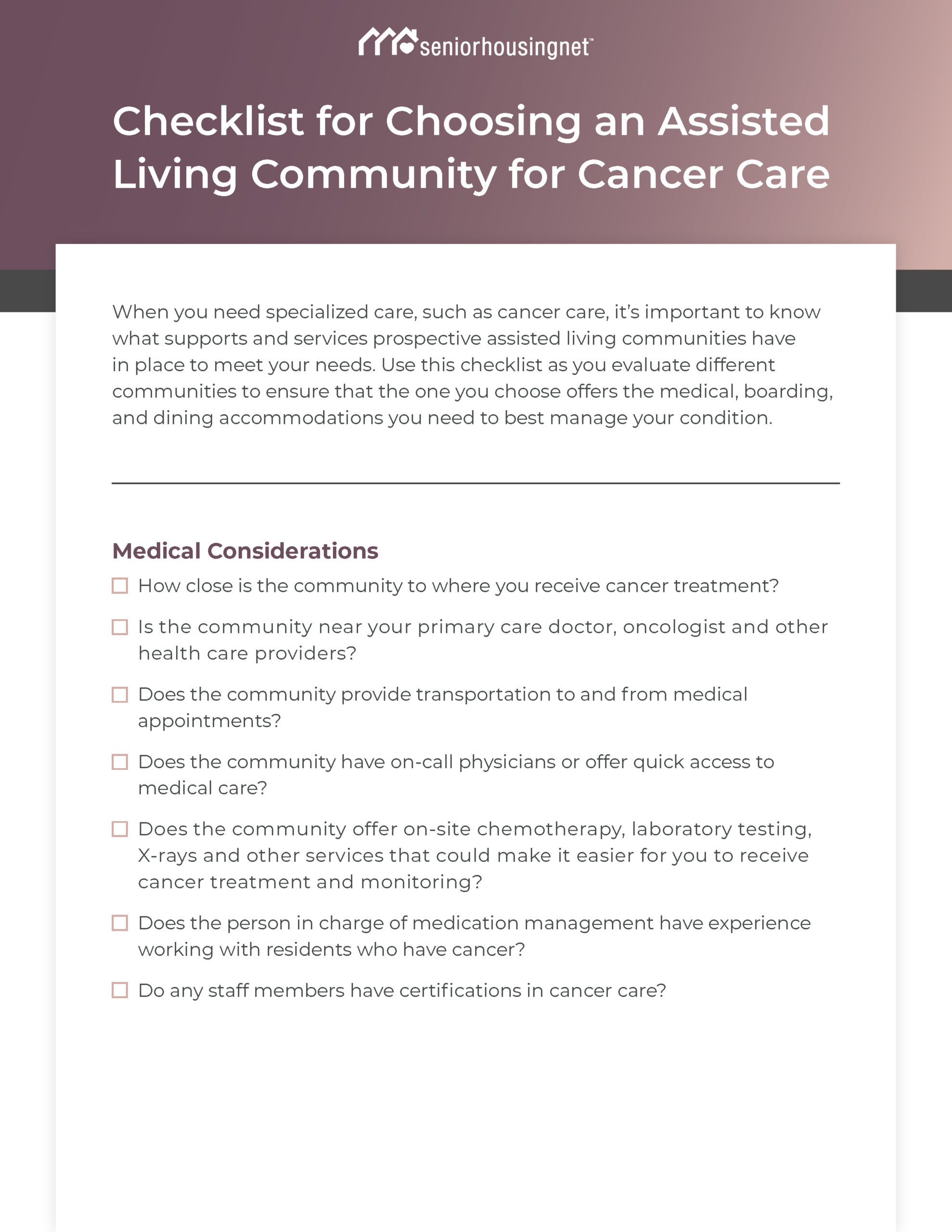A Guide to Making Cancer Care Decisions for Older Adults
Reviewed by: Deidre Sommerer, LPN, MS, CMC, CDP
Published/updated: September 15, 2022
Cancer, like cardiovascular disease, diabetes and hypertension, is a disease commonly associated with aging. According to the American Society of Clinical Oncology, those aged 65 and over account for 6 out of 10 cancer diagnoses and 7 out of 10 cancer deaths in the United States.
Cancer treatment is always challenging. In many cases, individuals must make quick decisions that may have long-term consequences, find support as they progress through treatment and manage side effects from medications. However, for older adults, there are other considerations that make treatment even more difficult to navigate.
Aside from being associated with an increased risk of developing cancer, age has a profound impact on how the individual responds to certain treatments. Seniors are more likely to have chronic conditions that may complicate treatment options. Even those who are generally healthy may respond differently to therapies than younger patients. For example, seniors generally have more serious side effects from chemotherapy, and in many cases, anticancer drugs aren’t as well-tolerated in seniors as they are in younger patients. Additionally, seniors may not have the same support system in place to help them get through the highs and lows of treatment.
In this guide, we explore how a cancer diagnosis impacts your long-term care needs and options. We also provide an overview of some assisted living and nursing home facilities that provide compassionate care for those living with cancer.
The Challenges of Obtaining Cancer Care as a Senior
When it comes to obtaining effective cancer treatment, seniors have more barriers to overcome than younger patients. These barriers can have an impact on their access to important information, range of treatment options and quality of life. By recognizing common roadblocks to comprehensive cancer treatment, seniors and their families can know the right questions to ask health care providers and make informed decisions regarding their living environment.
Limited Access to Transportation
Depending on the type of cancer a senior has, they may be in active treatment anywhere from a few weeks to a few months. Even after active treatment is over, they will likely still need to see their doctor every few months. Aside from being disruptive, these regular medical appointments can be challenging to manage for older adults, especially those who don’t drive.
Assisted living facilities generally provide complimentary or low-cost transportation services and accompaniment from medical appointments. Living in a residential facility makes it easier for older adults to regularly attend medical appointments without having to arrange their own transportation to and from their health care provider.
Limited Access to Health Care
Depending on where an individual lives, it may be challenging to access regular medical care. This is particularly true for older adults who live in rural areas. Assisted living facilities generally have visiting physicians who provide comprehensive medical care for residents, ensuring regular care even in underserved areas.
Unsafe Living Environments
Safe, sanitary environments are important for older adults receiving cancer treatment. Some types of aggressive treatments can leave the individual feeling very tired or unsteady on their feet. Home modifications such as grab bars and stair lifts aren’t practical or financially feasible for everyone, and during treatment, maintaining a clean environment can be especially challenging.
Assisted living facilities have environments conducive to healing with safety features, regular housekeeping and trash removal services and access to mobility aids. Facilities also serve daily meals and can generally accommodate special dietary needs, further supporting healing for those in active treatment.
Lack of Companionship
Cancer treatment can be lonely and isolating, particularly for those who live alone. Assisted living residents interact daily with caring staff and fellow residents and participate in age-friendly social and recreational activities as they’re able, helping to prevent boredom and social isolation.
Finding Long-Term Care Options After a Cancer Diagnosis

For those with cancer, residential senior living is a practical option that can greatly improve their quality of life. Assisted living facilities and home care agencies promote a safe, clean environment with healthy meals served daily, regular housekeeping and laundry service, emotional support and transportation for medical appointments, all of which are beneficial for those in cancer treatment.
Many types of cancer are treatable, but the recovery process can make it difficult to handle daily living activities such as personal grooming, housekeeping duties and laundry. Residential care provides a low-maintenance lifestyle that reduces residents’ responsibilities and stress, making it a great option for those in treatment.
There are several long-term care options for adults with cancer that can provide them with the help and emotional support they need.
Home-Based Care
Many older adults with cancer prefer remaining in the comfort and privacy of their own homes for as long as possible. Obtaining home-based care gives seniors more control over their daily schedules and the caregivers who provide services.
There are two levels of home-based care available: home care and home health care. For those who require skilled nursing services, such as medication administration and disease management, home health care may be the appropriate option. For those who simply need help with activities such as personal grooming, managing household chores, meal preparation and transportation, home care may provide an adequate level of service.
While home-based care is a convenient option, it can be expensive. On average, home care agencies charge $4,957 per month for care. Those who need skilled nursing services pay approximately $5,148 per month. This assumes 44 hours of weekly care, so if you need more than 9 hours of care per weekday, your care costs could be higher.
Assisted Living
Assisted living is a practical option for those who need help with daily living activities but don’t require around-the-clock medical monitoring. These facilities have homelike environments with studio and one- and two-bedroom apartments that residents can typically furnish with their own belongings. Residents have access to healthy meals prepared daily, housekeeping and linen service and transportation and accompaniment to medical appointments. They also have personalized care plans, and depending on state regulations, many facilities have registered nurses and physicians on staff or on call. In some cases, assisted living facilities provide cancer-specific care for residents with specially trained caregivers and oncology teams.
Assisted living is considerably more cost-effective than in-home care, with national data showing that seniors in residential care spend about $5,000 less annually than those who arrange home care. In the United States, seniors in assisted living pay $4,500 per month for services, on average, making it a relatively affordable long-term care option. Those who need cancer-specific care and services may pay higher monthly rates, depending on the facility they choose.
Nursing Home Care
For seniors who need help with most or all activities of daily living, medical supervision and rehabilitative therapy, nursing home care may be necessary. These facilities provide the highest level of care available outside of an inpatient hospital setting, including 24-hour medical supervision and skilled nursing care, housekeeping, personal care and meals. They’re staffed with physicians and nurses who provide services such as IV and catheter care and medication administration. All nursing homes comply with minimum standards for care set by the federal government, and some states have additional licensing and certification requirements.
Nursing home care is the costliest senior care option for those with cancer. On average, seniors pay $7,908 per month for semiprivate rooms and $9,034 for private accommodations.
Hospice Care
Depending on the type and stage of the cancer, curative treatment may not be feasible. This is especially true when aggressive treatment is not a viable or attractive option.
The purpose of hospice is to prioritize the individual’s comfort and quality of life. This type of care is provided by a multidisciplinary team that provides emotional support for the individual and their loved ones as well as medical care to minimize pain and discomfort. Seniors may obtain hospice care at home, in assisted living and in a nursing home, depending on their state’s rules.
What to Consider When Researching the Best Long-Term Care Option for Cancer Care
To make an informed decision on what care setting is the most appropriate, it’s important to understand the diagnosis, treatment and expected outcome. This requires communicating with the health care team treating you or your loved one, including members of the oncology, pathology and radiology team.
Diagnosis and Prognosis
When deciding between in-home care, assisted living and nursing home care, consider the level of medical care the individual will receive. If the individual requires or is expected to require 24-hour monitoring or care, IV chemotherapy, subcutaneous or intramuscular injections or antibiotics, they may need to live in a nursing home. If they only need help with daily living activities, medication reminders, and scheduling and attending medical visits or if they decide not to pursue cancer treatment, in-home care or assisted living may be suitable.
Age
Older adults have unique challenges, including bone loss, depression, cognitive decline and dementia, when it comes to navigating cancer treatment compared to younger individuals. These and other factors affect the type of treatment offered and how well the individual tolerates it. In some cases, the risks associated with surgery and chemotherapy outweigh the potential benefits for older patients.
It’s important to discuss how age may be a factor in cancer treatment and pain management strategies, including how age-related conditions such as diabetes could complicate treatment.
Environment
When deciding between living at home and transitioning to a community setting, it’s helpful to consider whether the home environment is conducive to recovery. Many seniors benefit from home modifications such as ramps, widened doorways, rails, stairlifts and walk-in tubs. These modifications aren’t always financially feasible or possible, depending on the home. Some people may require medical equipment such as hospital beds and patient lifts, which not all homes have room for.
In addition to the house’s physical environment, it’s also important to consider its social environment. If the individual lives alone or with someone who has their own care needs, they may not have the help they need with personal care and basic household chores. If they live alone and don’t have someone available to help them all day, their safety may be jeopardized and they may be at a greater risk for loneliness or isolation.
Re-Evaluate Often
Many seniors are able to remain in their own homes during the early stages of cancer, but as their condition progresses, living alone may no longer be safe or comfortable. The individual, their health care team and their family should evaluate their condition and living situation often to ensure that it’s a good fit for their needs.
Finding Assisted Living Facilities That Provide Cancer Care

Not all assisted living facilities provide the care services individuals with cancer need during their treatment. When researching local facilities, it’s helpful to keep a few key factors in mind. The following checklist highlights things to consider when you’re choosing an assisted living facility for cancer care.
Nationwide Assisted Living and Nursing Home Chains That Provide Cancer Care
There are several nationwide senior living chains that provide specialized care for those with cancer.
| Facility | Contact | Description |
| Elderwood | (888) 826-9663 | Elderwood is a senior living community that provides multiple levels of care, including skilled nursing, assisted living, in-home and respite care. It has a specially trained staff that provides cancer treatment to help residents transition out of a hospital or nursing home setting to a less intensive environment. Its oncology team includes nurses, board-certified physicians and trained caregivers who help residents with cancer manage their treatment and access necessary personal care services. Some Elderwood communities allow spouses to live with their partner who is in treatment. |
| Brookdale Senior Living | (855) 939-4720 | Brookdale Senior Living is a highly rated national chain that provides multiple levels of care for older adults, including palliative care and hospice. It provides care coordination with residents’ doctors to ensure the appropriate level of care and services, and it provides around-the-clock on-call support. It also provides family support groups, skilled nursing services and all medications necessary for the individual’s treatment. |
| Holiday Retirement | (800) 322-0999 | Holiday Retirement operates 240 senior living facilities throughout 43 states, making it one of the largest providers in the United States. It creates personalized care plans to address each resident’s unique needs and works closely with health care providers to monitor changes in condition and effectiveness of treatments. The company also has a Travel and Stay program that allows residents to stay at any Holiday retirement community in the nation for free for up to 7 days, which may benefit those who travel for cancer treatment. |
| Five Star Senior Living | (617) 796-8387 | Five Star Senior Living has 260 communities in 33 states that provide multiple levels of care, including independent living, assisted living and memory care. It has signature programs that are designed to help residents regain their strength and independence after an illness. It has a highly trained care team that provides physical rehabilitation and wellness services, and it provides amenities such as laundry, room service and concierge services. |
| Sunrise Senior Living | (703) 273-7500 | Sunrise Senior Living has decades of experience in providing residential care for older adults. It operates over 320 locations across the country, many of which have been nationally recognized for providing outstanding care. Facilities provide multiple levels of service, including assisted living, respite care and skilled nursing, and home care is available in some locations. Sunrise Senior Living also helps coordinate hospice services to meet the needs of those needing end-of-life care. |
| Erickson Senior Living | (800) 917-8189 | Erickson Senior Living manages 21 senior living communities in 11 states. In addition to providing residential services, it provides health care with Erickson Health Medical Group, which is the largest senior living integrated health and wellness system in the nation. Facilities provide a full continuum of care, enabling residents to remain in the community even as their care needs evolve. |
| Atria Senior Living | Find a community | Atria Senior Living provides residential long-term care in 45 states and seven Canadian provinces, operating over 430 senior living communities altogether, making it one of the largest providers in the nation. Residents have access to a 24-hour staff and obtain services such as physical and occupational therapy, meal preparation and housekeeping. |
Finding the right assisted living facility can be challenging, especially for those looking for facilities that will provide specialized care for those in cancer treatment. To get free, personalized assistance with your search, contact a SeniorHousingNet local advisor at 800-304-7152.
Finding Hospice Services for Cancer Care
Not all cancer is curable, and in some cases, managing symptoms and promoting the highest quality of life possible is the best option for care. Through the following resources, you can find the information and support you need to choose the right hospice agency for you or your loved one.
| Resource | Description |
| The National Hospice and Palliative Care Organization | NHPCO is a nationwide nonprofit organization that promotes access to high-quality end-of-life care. Through its local hospice provider tool, you can find agencies in your region that provide services in home and community settings. The organization also offers tips for choosing a provider and navigating issues such as creating advance directives and using Medicare or Medicaid to pay for care. |
| The Hospice Foundation of America | The Hospice Foundation of America publishes a helpful overview of things to consider when choosing and comparing hospice providers. It outlines questions that should be asked when interviewing a hospice and provides helpful information on how to prepare for services. |
| The National Association of Home Care & Hospice | The National Association of Home Care & Hospice has a Home Care/Hospice Agency Locator that contains over 33,000 agencies throughout the country. Individuals can use this locator tool to identify all the hospice agencies in their region. |
| CMS Hospice Care Locator | The CMS Hospice Care Locator has a searchable database with all Medicare-registered hospice agencies in the United States. Individuals can provide their location in the search and get detailed descriptions of all local hospice agencies, including the conditions they most commonly treat, whether they are Medicare-compliant and if they are a not-for-profit organization. |
SENIOR CARE RESOURCES
-
1
A Caregiver’s Guide to Obesity and Senior Living
Dec 8, 2022.10 min read
-
2
What You Need To Know About The Benefits of Reading and Libraries for Seniors
Dec 5, 2022.7 min read
-
3
Emergency Housing Guide
Nov 18, 2022.46 min read




